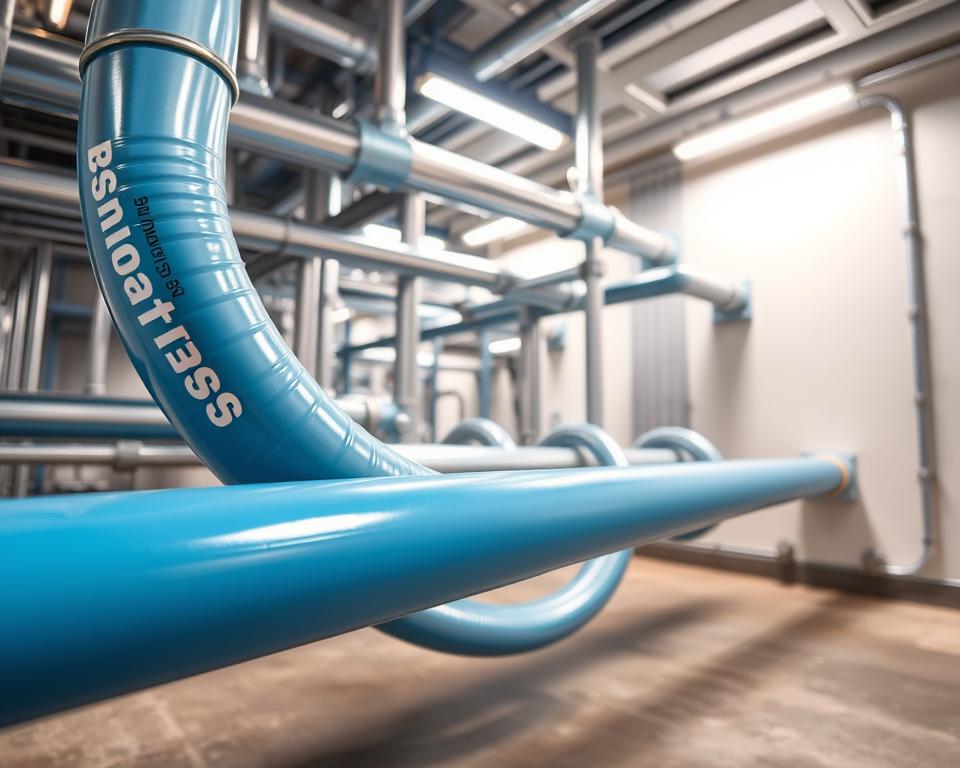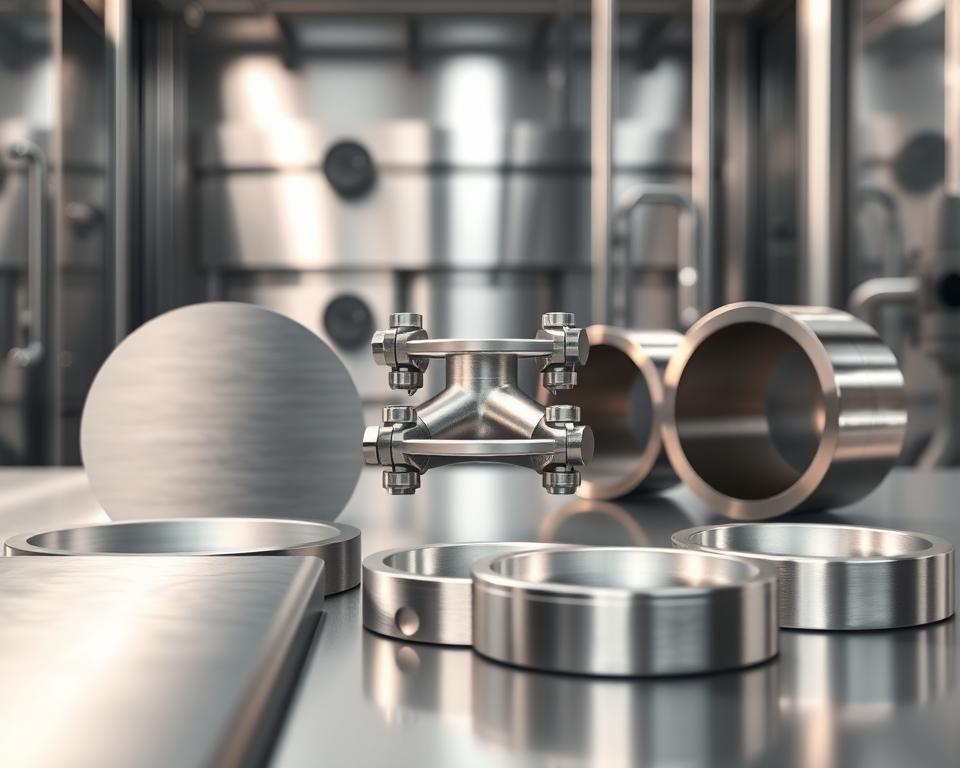Chromium Oxide Green Refractory Uses Explained.
Did you know that around 80% of the world’s chromium production is used for producing refractories? Green chromium oxide, scientifically known as Cr2O3, is a standout for its exceptional properties. These qualities turn it into key in thermal uses. It increases strength and resistance to oxidation in numerous industrial processes.
This article will examine the wide range of uses of chromium oxide green in refractory materials. We will emphasize its role in today’s industrial landscape. Let’s uncover why this multi-functional substance is indispensable.
Introduction to Chromium Oxide Green
Chromium oxide green is a vibrant green substance renowned for its versatility and sturdiness. It is crucial in the sector of refractories thanks to its distinct features. This material not only enhancing the aesthetic value of manufactured goods, but also delivers substantial industrial gains for challenging industrial uses.
In the refractory industry, green chromium oxide has a key function. It improves the heat resistance and longevity of products in challenging settings. This covers applications in iron and steel industries and glass production. As companies evolve, the material’s importance increases, offering solutions for extreme heat applications where performance is essential.
Chromium oxide green is not merely a colorant; it’s a vital component for durable industrial applications. Its versatility and robustness render it a key ingredient in the manufacture of high-performance refractories.
Grasping Chromium Oxide and its Makeup
Green chromium oxide, primarily known Cr2O3, is a compound composed of chromium element and oxygen atoms. Its structure of chromium oxide exhibits distinct properties that improve its use across various sectors. This chemical configuration is solid and reliable, providing endurance in challenging environments.
The refractory properties of chromium oxide are prominent in industries demanding substances that tolerate extreme heat. It shows a robust power to withstand heat stress. This makes it suitable for smelting and other industrial processes where temperature is vital.
Understanding the details of chromium oxide composition assists sectors exploit its natural advantages. Its resilience under stress enhances overall performance. This establishes chromium oxide as a top choice among refractory materials.
Significance of Chromium Trioxide in Refractories
Trioxide of chromium is essential for the performance of refractory materials due to its unique properties. It improves the reliability and durability of these substances in harsh environments. This knowledge is crucial for grasping its role alongside green chromium oxide in a range of uses.
Role of Chromium Trioxide in Enhancing Stability
Heat-resistant compounds are required to endure extreme heat without breaking down. Chromium trioxide enhances their ability to resist heat and structural integrity. This results in less wear and tear, turning it into key for sectors needing durable compounds.
Side-by-Side Evaluation of Chromium Oxide and Trioxide of Chromium
Green chromium oxide and chromium trioxide have distinct roles in refractory compounds. Both are crucial, but differ in their qualities:
| Property | Green Chromium Oxide | Chromium Trioxide |
|---|---|---|
| Thermal Stability | Reliable heat resistance | Superior heat tolerance |
| Area of Use | Frequently applied in refractories | Optimal for intense thermal scenarios |
| Longevity | Moderate durability | Significantly boosts durability |
This analysis emphasizes the unique contributions of chromium oxide and trioxide of chromium to thermal-resistant substances. Their unique traits improve efficiency and lifespan in various industrial settings.
Heat Tolerance Traits of Green Chromium Oxide
Chromium oxide green demonstrates exceptional traits, turning it into suitable for intense heat environments. Its melting point can soar to 2400°C, providing exceptional structural integrity in extreme conditions. This is important for companies needing durability, particularly in steel smelting processes.
Fusion Temperature and Build Quality
Chromium oxide green is famous for its ability to endure high temperatures, vital for maintaining refractory structural integrity. This high-temperature resistance lets it withstand intense temperatures without losing shape. Its heat resistance turns it into a necessity in applications requiring reliability.
Applications in Steel Smelting
In iron and steel production, green chromium oxide’s ability to withstand heat is crucial. It’s often used in thermal-resistant building blocks for kilns and heat chambers. These bricks endure extreme environments and must endure. Chromium oxide green’s high melting point makes them effective, improving efficiency in metalworking.
Benefits of Green Chromium Oxide in Refractories
Chromium oxide green significantly enhances refractory compounds, important for various industrial uses. It enhances physical traits and oxidation resistance. These enhancements boost the durability and performance of refractory products.
Improvement of Mechanical Properties
Adding chromium oxide green into refractories significantly improves their mechanical properties. Main advantages involve:
- Boosted resilience: Green chromium oxide’s strength boosts the longevity of substances against damage.
- Enhanced wear resistance: Its makeup reduces damage from heavy usage, extending refractory life.
- Higher flexural strength: This trait allows heat-resistant materials to endure mechanical stresses, making it ideal for challenging environments.
Oxidation Endurance in Extreme Heat
Green chromium oxide’s resistance to oxidizing conditions is crucial in extreme heat settings. The advantages are:
- Increased durability: Refractories last longer, withstanding intense heat.
- Improved functionality: They undergo less wear and tear, allowing for consistent output in sectors.
- Lower maintenance costs: Less need for substitution of substances cuts costs for refractory-dependent operations.
These green chromium oxide benefits improve the durability of heat-resistant materials and encourage sustainable use. They increase the longevity of materials and lessen material waste.
Chromium Oxide Green Refractory Uses Explained
Green chromium oxide has become crucial in many industries thanks to its unique characteristics. It is effective in different industries, from metal manufacturing to glassmaking. Its function as a critical component in refractory materials underscores its significance.
Applications in Various Industries
Chromium oxide green is vital in several sectors for better performance. Here are the key sectors and their major roles:
- Steel Industry: It’s applied in making refractory bricks and thermal-resistant castables, ensuring heat resistance and abrasion resistance.
- Glassworks: In heat-resistant coatings, it ensures thermal endurance and provides resistance to chemical reactions.
- Ceramics: As a colorant in ceramic finishes, it provides coloration, strength, and structural integrity.
- Cement Production: It improves the properties of refractory materials for extreme heat settings.
Wide Range of Refractory Material Applications
Chromium oxide green’s adaptability extends beyond individual sectors. Its uses cover a wide range, such as:
- High-performance refractory bricks
- Moldable refractory materials for harsh environments
- Anti-corrosive refractory coatings
- Special ceramics needing thermal properties
This diverse field of applications demonstrates chromium oxide green’s importance in enhancing industrial efficiency. Its unique qualities help industries achieve their operational goals, promising better performance and material longevity.
Key Industrial Uses of Chromium Oxide Green
Chromium oxide green is crucial in multiple sectors, recognized for its versatility and performance. It is primarily applied in the field of heat-resistant materials, improving heat resistance and mechanical strength. This material is critical in materials developed for challenging settings.
In the production of thermal-resistant components and inner linings, green chromium oxide is prominent. These components are vital in intense thermal situations like ovens, smelting chambers, and incinerators. Incorporating green chromium oxide enhances their functionality, ensuring they last longer and offer dependable use.
- Ceramics: Green chromium oxide is important in ceramics, boosting color consistency and structural integrity.
- Metallurgy: It is utilized in metal processes for equipment and items requiring heat tolerance.
- Glass Industry: In glassmaking, green chromium oxide delivers the longevity of glassmaking chambers.
This compound is vital outside standard uses but also in innovative materials. The push for energy-efficient solutions is promoting its application in advanced refractory composites.
As sectors focus on performance and productivity, chromium oxide green remains essential. Its wide range of uses shows its importance across different industries. This confirms its significance in the modern refractory industry.
Green Chromium Oxide Manufacturing Processes
The creation of green chromium oxide uses multiple proven methods, each with distinct benefits and issues. These techniques are crucial for manufacturing refined chromium oxide green, necessary for its wide-ranging roles. Processes such as burning, aqueous processes, and settling are key in manufacture and product consistency.
Widely-Used Manufacturing Methods
Several common preparation methods are applied in chromium oxide green manufacture. These consist of:
- Combustion Method: This process consists of the combustion of chromium salts with organic materials. It is productive and has a low environmental impact.
- Hydrothermal Method: This method applies the interaction of chromium oxides in an aqueous solution under intense pressure and thermal conditions. It creates highly crystalline materials.
- Solid Formation Process: This method involves the solid formation of chromium oxides from liquid mixtures. It permits management over particle size and shape.
Each technique provides distinct benefits, such as affordability and ability to scale, but also presents challenges like purity and particle size variations. Selecting the right method strongly influences the final product’s properties and its applicability for specific applications.
Ensuring Quality in Manufacturing
Ensuring product quality is vital in the production of green chromium oxide. It makes certain the final product complies with regulations for refinement and consistency. Important quality control aspects are:
- Regular testing of base substances to maintain material quality for manufacturing chromium oxide green.
- Monitoring of production parameters, such as heat and pressure, during the different preparation methods.
- Final product testing for structure and physical properties, ensuring compliance with desired specifications.
Effective quality control procedures improve the trustworthiness and efficiency of chromium oxide green for its various industrial applications. This underscores the vital nature of these manufacturing processes in the complete manufacturing system.
Eco-Friendly Practices in Chromium Oxide Green Manufacturing
The trend toward eco-friendliness is changing the green chromium oxide sector. Sustainability concerns is now a major priority as companies seek methods to lower environmental impact. By incorporating sustainable practices, they lower harmful output and conserve materials.
Integrating sustainability into chromium oxide green production aligns with environmental regulations and market expectations. Manufacturers are now increasingly mindful of their eco-footprint. By adopting new technologies, they gain advantages such as:
- Using waste materials in production, which reduces reliance on raw materials.
- Enhancing production efficiency in manufacturing.
- Enhancing recycling practices to lessen damage to the environment.
The eco-friendly application of green chromium oxide is also obvious in different fields. For instance, it plays a key role in emission reduction systems, reducing toxic output. This demonstrates the vital role of environmental responsibility in the refractory industry.
| Technique | Overview | Environmental Benefit |
|---|---|---|
| Resource Efficiency | Utilizing by-products in creation | Minimizes raw material extraction |
| Energy Use | Techniques to lower energy consumption | Reduces energy-related emissions |
| Pollution Management | Incorporating pollution control technology | Lessens harmful pollutants released |
| Recycling Practices | Optimizing waste recycling processes | Reduces landfill usage |
As sectors focus on sustainability, the manufacture of green chromium oxide and use are notable. They illustrate how eco-conscious methods and forward-thinking processes can collaborate, paving the way for a more sustainable future.
Future Innovations in Chromium Oxide Green Use
The landscape of refractory applications is set for major changes, notably with progress in green chromium oxide use. As companies aim for eco-friendly practices, the future development of this compound becomes increasingly crucial.
Emerging technologies are driving innovation in chromium oxide green’s applications, including:
- Improved heat resistance for improved durability in challenging settings.
- Innovative blends that increase its role in metalworking and clay-based products.
- Advanced production methods to lower emissions while maintaining quality.
Chromium oxide green’s integration into new heat-resistant materials ensures strong results for sectors worldwide. Continuous research and development is set to leverage this material’s distinct characteristics. This guarantees it continues to be key in cutting-edge refractory technology.
By embracing these advancements, industries can improve the efficiency and sustainability of their heat-resistant materials. This makes the future of chromium oxide green highly successful.
Summary
Green chromium oxide is a key compound that enhances the strength and efficiency of refractory components across various fields. Its distinct characteristics, such as high-temperature resistance and oxidation resistance, are vital for iron and steel manufacturing and ceramics industries.
The discussion of the uses of green chromium oxide demonstrates its adaptability and importance in current industrial needs. Future developments in production increase its future uses, ensuring it stays important for reliable applications.
As the push for sustainable manufacturing expands, the use of chromium oxide green is likely to expand. Its use in developing green heat-resistant products highlights its key function in the next generation of heat-resistant materials. This ensures better functionality and efficiency in a fast-changing industrial field.



